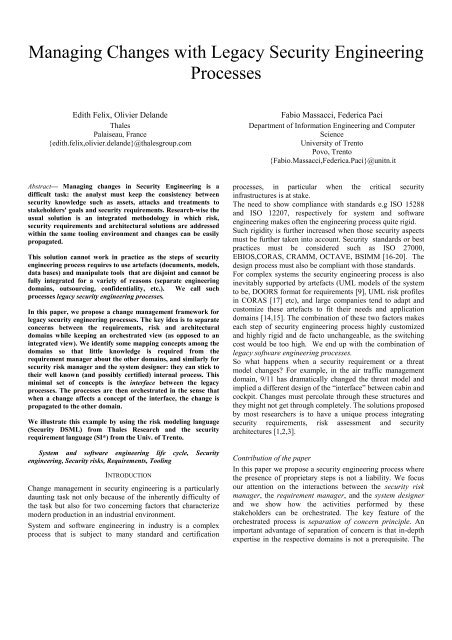D.3.3 ALGORITHMS FOR INCREMENTAL ... - SecureChange
D.3.3 ALGORITHMS FOR INCREMENTAL ... - SecureChange
D.3.3 ALGORITHMS FOR INCREMENTAL ... - SecureChange
Create successful ePaper yourself
Turn your PDF publications into a flip-book with our unique Google optimized e-Paper software.
Managing Changes with Legacy Security Engineering<br />
Processes<br />
Edith Felix, Olivier Delande<br />
Thales<br />
Palaiseau, France<br />
{edith.felix,olivier.delande}@thalesgroup.com<br />
Fabio Massacci, Federica Paci<br />
Department of Information Engineering and Computer<br />
Science<br />
University of Trento<br />
Povo, Trento<br />
{Fabio.Massacci,Federica.Paci}@unitn.it<br />
Abstract— Managing changes in Security Engineering is a<br />
difficult task: the analyst must keep the consistency between<br />
security knowledge such as assets, attacks and treatments to<br />
stakeholders' goals and security requirements. Research-wise the<br />
usual solution is an integrated methodology in which risk,<br />
security requirements and architectural solutions are addressed<br />
within the same tooling environment and changes can be easily<br />
propagated.<br />
This solution cannot work in practice as the steps of security<br />
engineering process requires to use artefacts (documents, models,<br />
data bases) and manipulate tools that are disjoint and cannot be<br />
fully integrated for a variety of reasons (separate engineering<br />
domains, outsourcing, confidentiality, etc.). We call such<br />
processes legacy security engineering processes.<br />
In this paper, we propose a change management framework for<br />
legacy security engineering processes. The key idea is to separate<br />
concerns between the requirements, risk and architectural<br />
domains while keeping an orchestrated view (as opposed to an<br />
integrated view). We identify some mapping concepts among the<br />
domains so that little knowledge is required from the<br />
requirement manager about the other domains, and similarly for<br />
security risk manager and the system designer: they can stick to<br />
their well known (and possibly certified) internal process. This<br />
minimal set of concepts is the interface between the legacy<br />
processes. The processes are then orchestrated in the sense that<br />
when a change affects a concept of the interface, the change is<br />
propagated to the other domain.<br />
We illustrate this example by using the risk modeling language<br />
(Security DSML) from Thales Research and the security<br />
requirement language (SI*) from the Univ. of Trento.<br />
System and software engineering life cycle, Security<br />
engineering, Security risks, Requirements, Tooling<br />
INTRODUCTION<br />
Change management in security engineering is a particularly<br />
daunting task not only because of the inherently difficulty of<br />
the task but also for two concerning factors that characterize<br />
modern production in an industrial environment.<br />
System and software engineering in industry is a complex<br />
process that is subject to many standard and certification<br />
processes, in particular when the critical security<br />
infrastructures is at stake.<br />
The need to show compliance with standards e.g ISO 15288<br />
and ISO 12207, respectively for system and software<br />
engineering makes often the engineering process quite rigid.<br />
Such rigidity is further increased when those security aspects<br />
must be further taken into account. Security standards or best<br />
practices must be considered such as ISO 27000,<br />
EBIOS,CORAS, CRAMM, OCTAVE, BSIMM [16-20]. The<br />
design process must also be compliant with those standards.<br />
For complex systems the security engineering process is also<br />
inevitably supported by artefacts (UML models of the system<br />
to be, DOORS format for requirements [9], UML risk profiles<br />
in CORAS [17] etc), and large companies tend to adapt and<br />
customize these artefacts to fit their needs and application<br />
domains [14,15]. The combination of these two factors makes<br />
each step of security engineering process highly customized<br />
and highly rigid and de facto unchangeable, as the switching<br />
cost would be too high. We end up with the combination of<br />
legacy software engineering processes.<br />
So what happens when a security requirement or a threat<br />
model changes? For example, in the air traffic management<br />
domain, 9/11 has dramatically changed the threat model and<br />
implied a different design of the “interface” between cabin and<br />
cockpit. Changes must percolate through these structures and<br />
they might not get through completely. The solutions proposed<br />
by most researchers is to have a unique process integrating<br />
security requirements, risk assessment and security<br />
architectures [1,2,3].<br />
Contribution of the paper<br />
In this paper we propose a security engineering process where<br />
the presence of proprietary steps is not a liability. We focus<br />
our attention on the interactions between the security risk<br />
manager, the requirement manager, and the system designer<br />
and we show how the activities performed by these<br />
stakeholders can be orchestrated. The key feature of the<br />
orchestrated process is separation of concern principle. An<br />
important advantage of separation of concern is that in-depth<br />
expertise in the respective domains is not a prerequisite. The


